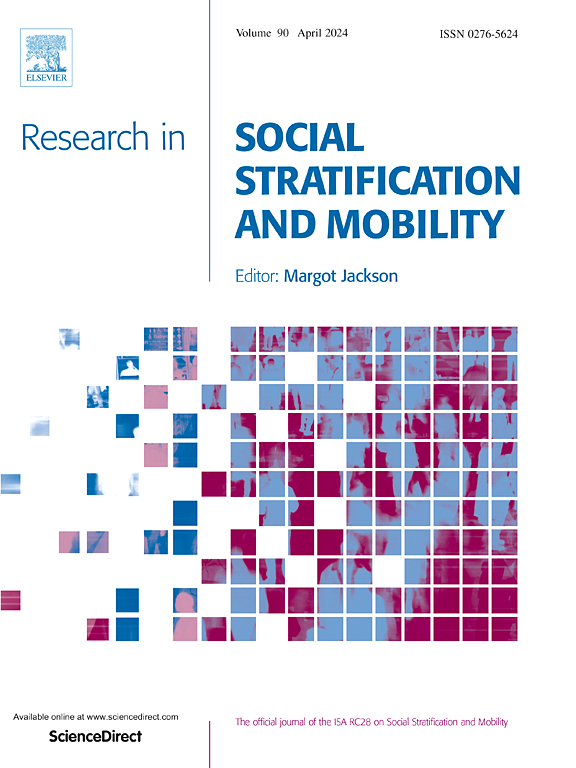Human capital and the upward occupational mobility of rural migrant workers in China
IF 2
1区 社会学
Q1 SOCIOLOGY
引用次数: 0
Abstract
Research on the human capital and occupational mobility of Chinese rural migrant workers often focuses on how formal education is linked to upward mobility, and rarely accounts for the heterogeneity in the origin occupations. Conditioning on origin occupations, this study uses multivariable logistic regression models to explore the relationship between four human capital factors including formal education, professional training, professional certificates and the knowledge of foreign languages, and the likelihood of upward occupational mobility among rural migrant workers in the urban labor market in China. The findings confirmed the overall positive associations between human capital and upward occupational mobility, net of family background and demographic characteristics. Nevertheless, heterogeneous marginal effects exist for different human capital factors. Formal education is associated with the upward mobility of migrant workers whose first occupations are professional technicians. Foreign language proficiency is associated with the upward mobility for those with an origin occupation of industrial production personnel or business and service personnel. There is evidence for cohort differences, that foreign language proficiency is associated with the upward mobility of the older cohort with an occupational origin of industrial production personnel, and of the younger cohort with an occupational origin of business personnel, whereas high school degree only matters for the older cohort. This study contributes understanding to the mobility and stratification literature by: 1) distinguishing between four human capital factors including formal education, professional training, certificates, and foreign language proficiency, and revealing the heterogeneity in their relationship with upward mobility; 2) providing an innovative empirical approach to understand the relationship between human capital and occupational mobility that accounts for the origin and destination occupations of mobility; 3) contributing a life course perspective by revealing the link between origin and destination occupations, between education and employment, between the younger and older cohort, and between structural barriers (or incentives) and individual agency for human capital investment.
人力资本与中国农民工职业向上流动
关于中国农民工人力资本和职业流动的研究往往侧重于正规教育如何与向上流动联系起来,而很少考虑到原籍职业的异质性。本研究以原籍职业为条件,运用多变量logistic回归模型,探讨正规教育、专业培训、专业证书和外语知识四种人力资本因素与中国城市劳动力市场农民工职业向上流动可能性之间的关系。研究结果证实了人力资本与向上职业流动、家庭背景和人口特征之间的总体正相关关系。但不同人力资本要素的边际效应存在异质性。正规教育与移民工人的向上流动有关,他们的第一职业是专业技术人员。对于那些原本从事工业生产人员或商业和服务人员的人来说,外语能力与向上流动有关。有证据表明队列差异,外语能力与年龄较大的工业生产人员队列和年龄较小的商业人员队列的向上流动有关,而高中学历仅与年龄较大的队列有关。本研究通过以下方式对流动与分层的相关文献进行了理解:1)区分了正规教育、专业培训、证书和外语水平这四个人力资本因素,揭示了它们与向上流动之间的异质性关系;2)提供了一种创新的实证方法来理解人力资本与职业流动之间的关系,解释了流动的起源职业和目的地职业;3)通过揭示原籍职业与目的地职业之间、教育与就业之间、年轻群体与年长群体之间、结构性障碍(或激励)与人力资本投资个体机构之间的联系,提供生命历程视角。
本文章由计算机程序翻译,如有差异,请以英文原文为准。
求助全文
约1分钟内获得全文
求助全文
来源期刊
CiteScore
7.80
自引率
6.00%
发文量
46
期刊介绍:
The study of social inequality is and has been one of the central preoccupations of social scientists. Research in Social Stratification and Mobility is dedicated to publishing the highest, most innovative research on issues of social inequality from a broad diversity of theoretical and methodological perspectives. The journal is also dedicated to cutting edge summaries of prior research and fruitful exchanges that will stimulate future research on issues of social inequality. The study of social inequality is and has been one of the central preoccupations of social scientists.

 求助内容:
求助内容: 应助结果提醒方式:
应助结果提醒方式:


